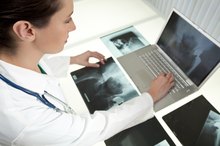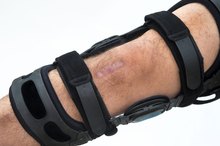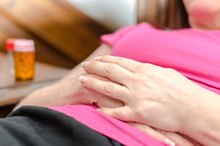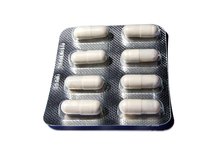Complications of Nasal Polyp Surgery
Nasal polyps are small, benign growths of tissue that develop within the lining of the nasal passageways or sinuses. Patients with large nasal polyps can experience severe breathing difficulties, decreased sense of smell, headaches, nasal congestion or snoring. These side effects of nasal polyps can be resolved through surgical removal of the noncancerous growths, a procedure called endoscopic sinus surgery. Patients should discuss the complications of nasal polyp surgery with a doctor prior to having this procedure performed.
If you are experiencing serious medical symptoms, seek emergency treatment immediately.
Cerebral Spinal Fluid Leakage
During nasal polyp surgery, a surgeon can accidentally damage the bone that provides a barrier between the nose and the brain. Damage to this bone can result in cerebral spinal fluid leakage. Approximately one percent of patients who undergo this surgical procedure experience cerebral spinal fluid leakage complications, according to Dr. Alberto D. Fernandez with the Baylor College of Medicine. Cerebral spinal fluid leakage increases a patient's risk of developing a severe brain and spinal cord infection called meningitis. Meningitis can be life-threatening and may cause severe headache, fever or stiff neck symptoms. Typically, leakage of cerebral spinal fluid is detected and repaired during nasal polyp surgery and does not cause additional complications. If the leak is not detected until after surgery is completed, affected patients may require additional surgery to repair the damaged bone.
- During nasal polyp surgery, a surgeon can accidentally damage the bone that provides a barrier between the nose and the brain.
Vision Alterations
Complications of Hiatal Hernia Surgery
Learn More
Eye injury can occur as a complication of nasal polyp surgery, Johns Hopkins Medicine reports 1. Affected patients may experience loss of vision; double or blurred vision; or excessive eye tearing. Certain patients may also notice extensive swelling or bruising around the eyes. Such complications are rare and typically resolve as a patient begins to heal after nasal polyp surgery.
- Eye injury can occur as a complication of nasal polyp surgery, Johns Hopkins Medicine reports 1.
- Such complications are rare and typically resolve as a patient begins to heal after nasal polyp surgery.
Nasal Scarring
Certain patients can develop scar tissue within the nasal passages as a complication of this surgical procedure, the University of California, San Diego, School of Medicine, warns. Nasal scarring is typically minor, but can cause changes in a patient's breathing patterns or sense of smell. Patients who continue to experience severe breathing difficulties through the nasal passages after surgery should consult a doctor.
- Certain patients can develop scar tissue within the nasal passages as a complication of this surgical procedure, the University of California, San Diego, School of Medicine, warns.
- Nasal scarring is typically minor, but can cause changes in a patient's breathing patterns or sense of smell.
Bleeding or Infection
Bump on the Inside of the Nose
Learn More
Nasal polyp surgery increases a patient's risk of developing bleeding or infection complications, Johns Hopkins Medicine explains 1. Mild bleeding or discharge from the nasal passages during or after surgery is normal and will subside as a patient continues to heal. Extensive bleeding during surgery may require a surgeon to immediately stop the nasal polyp surgery to limit blood loss. Rarely, patients may experience persistent or severe nasal bleeding after surgery. If this occurs, affected patients require prompt medical attention from a doctor. Patients who develop sinus infection symptoms after surgery, such as fever or nasal congestion, may require treatment with an antibiotic medication and should seek care from a physician.
- Nasal polyp surgery increases a patient's risk of developing bleeding or infection complications, Johns Hopkins Medicine explains 1.
- Patients who develop sinus infection symptoms after surgery, such as fever or nasal congestion, may require treatment with an antibiotic medication and should seek care from a physician.
Related Articles
References
- Johns Hopkins Medicine: Preparing for Endoscopic Sinus Surgery
- MayoClinic.com: Nasal Polyps - Symptoms
- American Academy of Allergy, Asthma, and Immunology. Nasal Polyps.
- National Institutes of Health. MedlinePlus. Nasal Polyps. Updated August 12, 2019.
- Bachert C, Han JK, Desrosiers M, et al. Efficacy and safety of dupilumab in patients with severe chronic rhinosinusitis with nasal polyps (LIBERTY NP SINUS-24 and LIBERTY NP SINUS-52): results from two multicentre, randomised, double-blind, placebo-controlled, parallel-group phase 3 trials [published correction appears in Lancet. 2019 Nov 2;394(10209):1618]. Lancet. 2019;394(10209):1638‐1650. doi:10.1016/S0140-6736(19)31881-1
- Astrazeneca. Three clinical trials announced for Fasenra in eosinophil-driven skin diseases.
Writer Bio
Rae Uddin has worked as a freelance writer and editor since 2004. She specializes in scientific journalism and medical and technical writing. Her work has appeared in various online publications. Uddin earned her Master of Science in integrated biomedical sciences with an emphasis in molecular and cellular biochemistry from the University of Kentucky College of Medicine.








